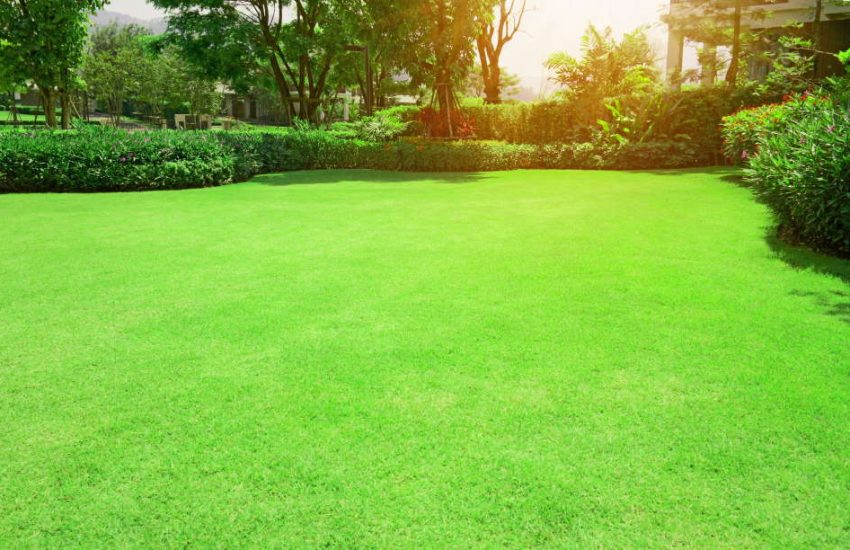Creating a Backyard Habitat for Wildlife and Sustainable Gardening
Creating a backyard habitat means shaping a space that welcomes local wildlife with food, shelter, water, and safe spots for raising young. A thoughtful backyard design draws in birds, pollinators, and helpful insects, boosting biodiversity and bringing a bit of wild right to your doorstep.
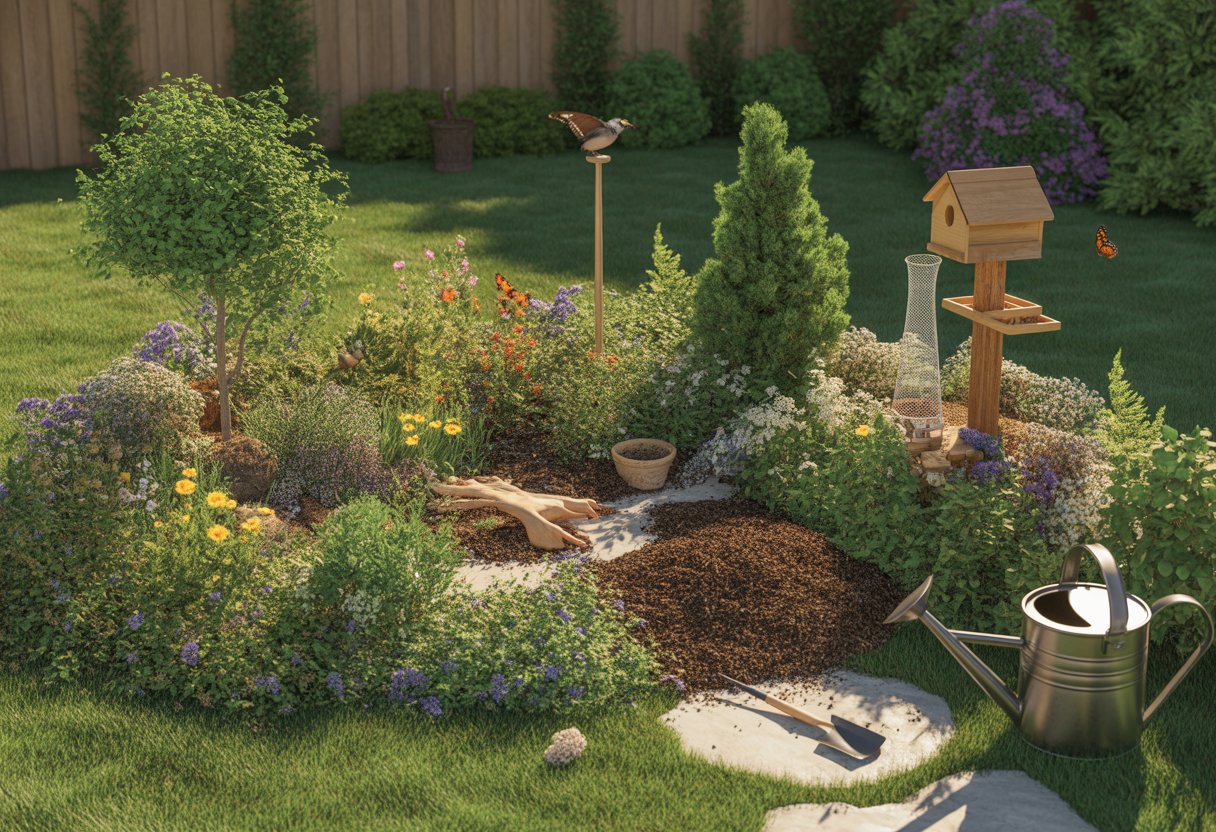
Pick native plants that already know how to thrive in your local climate—they’ll offer natural resources for wildlife without much fuss. Toss in things like bird feeders, water sources, or nesting boxes to make your yard even more inviting.
When you pay attention to what local critters need, you can turn any outdoor area into a lively, balanced habitat. It’s a win for nature, and honestly, it’s pretty rewarding and educational for you, too.
Planning Your Backyard Habitat
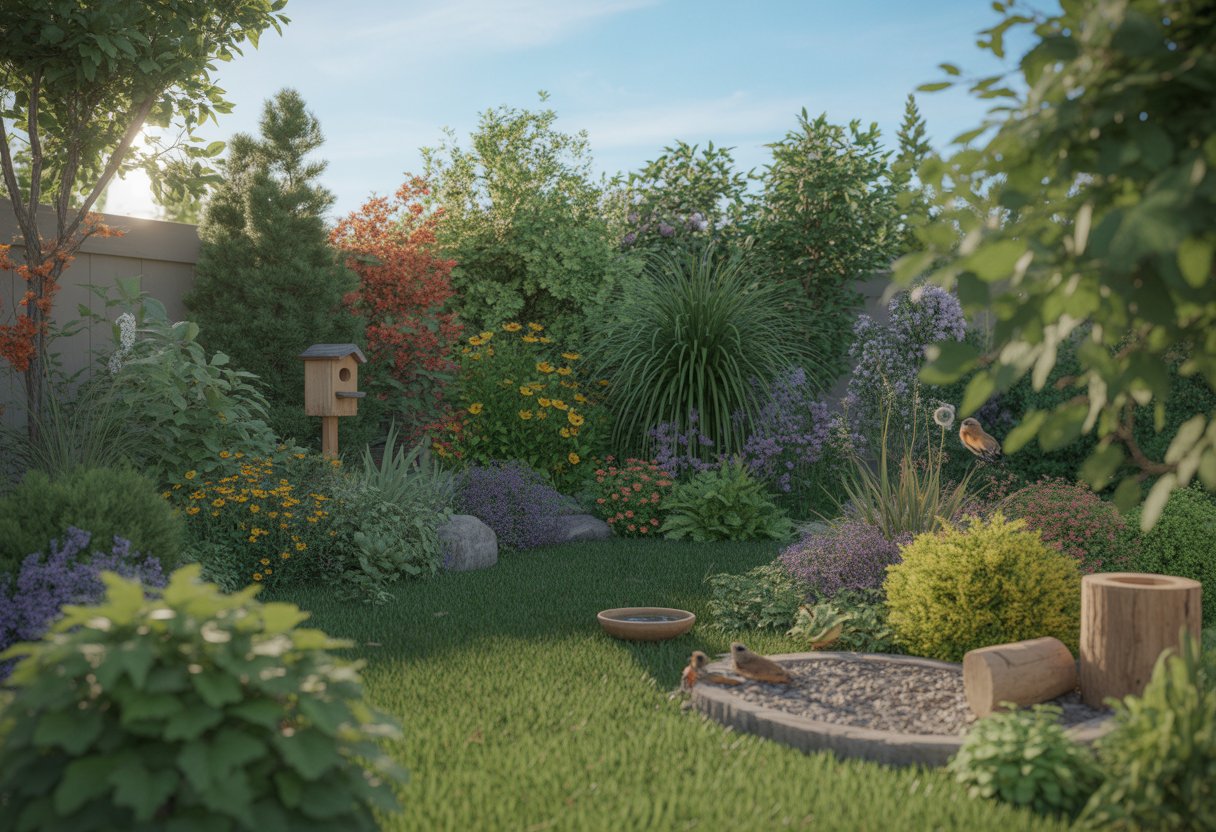
Smart planning goes a long way in supporting local wildlife. You’ll want to get a feel for your yard, set some goals, and shape spaces that offer a little something for every species.
Assessing Site Conditions
Start by sizing up your backyard’s quirks—think soil type, sunlight, moisture, and what’s already growing. In cities, you might have tough soil or shady spots thanks to buildings or fences, which can limit your plant choices.
Check for wildlife corridors or nearby green patches to help animals travel safely. Watch what critters already swing by, and keep an eye out for any invasive plants that could mess with your plans.
Once you know the lay of the land, it’s a lot easier to pick native plants that’ll actually do well and help the local ecosystem. This groundwork sets you up for a habitat that can handle a little chaos.
Setting Habitat Goals
Knowing what you want out of your habitat makes design way easier. Maybe you’re hoping for more pollinators, nesting birds, or a frog-friendly pond. Every goal points to different habitat features and ways to manage them.
Think about conservation needs and what your local ecosystem is missing. In urban spots, green spaces can be real lifesavers for wildlife. If you’ve got a favorite species, focus on what they need—nectar, shelter, or a water source.
Try to balance what looks good to you with what’s actually helpful for nature. If you can rope in a neighbor or two, or use your yard for teaching, all the better.
Designing for a Diverse Habitat
Mixing up plant types and layers—trees, shrubs, grasses, flowers—gives wildlife food, shelter, and places to breed all year long. Native plants hold up better and feed local animals that know what to expect.
Add in birdhouses, logs, or a water feature to create micro-habitats for everything from amphibians to insects. Keep an eye on the seasons and steer clear of planting just one thing everywhere.
Paths or corridors help critters get around, especially in city yards. A thoughtful, varied layout keeps things lively and supports more species than you might expect.
Providing Essential Resources for Wildlife
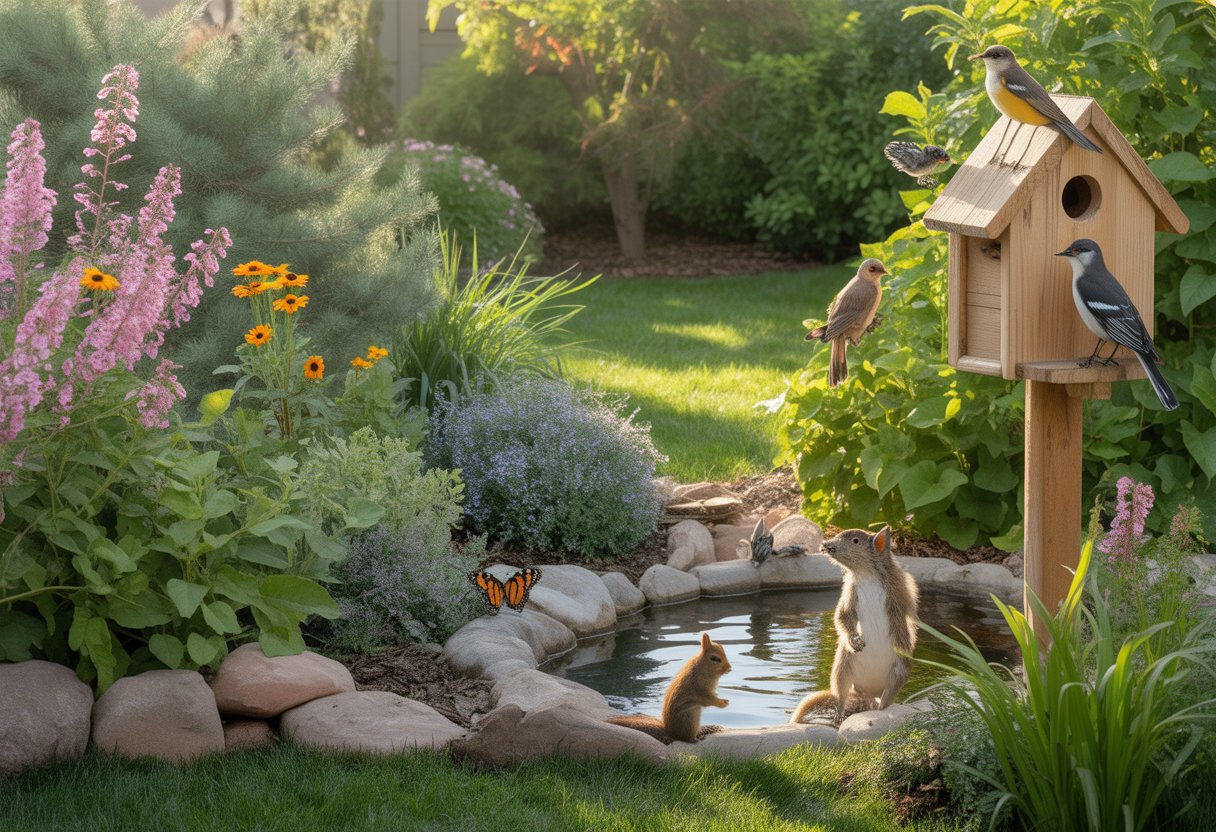
If you want wildlife to stick around, you’ve gotta give them what they need. Plants, food, water, and shelter all play their part—so choose and place them with care.
Choosing Native Plants and Wildflowers
Go for native plants and wildflowers—they’re already tuned to your climate and soil. Local insects, birds, and mammals know how to use them for food and shelter.
Wildflowers pull in pollinators like bees and butterflies with nectar they actually want. Try to stagger bloom times so there’s always something in season.
Plants with seeds and berries feed birds and small mammals. A mix of grasses, shrubs, and trees keeps things interesting and gives different critters a place to call home.
Creating Food Sources for Birds and Pollinators
Offer food for birds and pollinators both naturally and with a little help. Bird feeders with seeds, suet, or nectar bring in a variety of birds. Place feeders at different heights so everyone gets a shot.
Pollinators need blooms from native wildflowers all season long. Skip the non-native stuff that doesn’t offer much. Host plants for butterfly larvae mean you’ll get the whole butterfly life cycle, not just the adults.
Fallen fruit, nuts, and seed heads are lifesavers in autumn and winter. Ditch the pesticides—they’re bad news for food quality and safety.
Ensuring Clean Water Sources
Water’s a must for backyard wildlife. Birdbaths give birds a safe, easy drink—go shallow and vary the depth for different species.
Keep water clean to avoid spreading disease. A dripper or small fountain adds movement, which draws more visitors and keeps things fresh.
A small pond or damp patch helps amphibians and insects. Make sure water stays chemical-free and isn’t right where people walk all the time.
Designing Shelter and Nesting Sites
Wildlife needs shelter from weather and predators. Put up birdhouses made for local species—watch the entrance size and hang them at the right height.
Dense shrubs, brush piles, and leaf litter hide small mammals, amphibians, and insects. Leave some dead wood for cavity-nesting birds and beneficial bugs.
Layered vegetation, from ground cover to tall trees, offers a range of nesting spots. Don’t clear away all the natural debris—critters need those messy corners.
Maintaining and Enhancing Your Habitat
Keeping your backyard habitat going means regular care and a bit of flexibility. Focus on managing plants, soil health, and the mix of wildlife, and your ecosystem will reward you.
Managing Invasive Species
Invasives like Japanese knotweed or garlic mustard can take over fast. Check for them often and pull them out early before they get a foothold.
Hand-pulling works for small spots, but you might need targeted herbicides for bigger messes. Avoid overworking the soil, since that can spread seeds or roots. Healthy native plants fill gaps and crowd out invaders.
Hedgerows and ground covers act as natural barriers. Keeping these areas dense helps local animals and keeps invasives at bay.
Composting and Soil Health
Composting makes your soil richer and helps plants thrive. Toss in leaf litter, kitchen scraps, and garden waste to create a nutrient-rich base.
Turn your compost now and then to keep it airy and speed things up. Don’t compost invasive or diseased plants—no one wants that spreading. Use your finished compost on garden beds to boost soil life and hold in moisture.
Healthy soil brings in more plants and the decomposers that keep everything ticking. Mulch and ground covers help stop erosion and save water, too.
Seasonal Care and Adaptation
Change up your care routine as the seasons shift. In spring, plant natives and manage leaf litter to prep for breeding critters.
Summer calls for extra watering and weed control. Keep an eye on woodpiles—they can attract pests, but they’re also great for shelter. In autumn, add leaf litter and mulch to protect soil before the cold hits.
Winter’s a good time to leave things mostly alone and watch which animals take shelter. Adjusting with the seasons keeps your habitat in good shape year-round.
Encouraging Biodiversity
Mixing up the structure of your yard—hedgerows, layers, and woodpiles—brings in more species. Native flowers attract pollinators, which are absolutely key for everything else.
Let leaf litter be; decomposers and ground insects love it. Skip chemical pesticides so beneficial bugs can stick around and keep things balanced.
Add water sources and nesting sites for an extra boost. A patchwork of habitats in your backyard supports a web of life that’s stronger together.
Connecting With the Wildlife Community
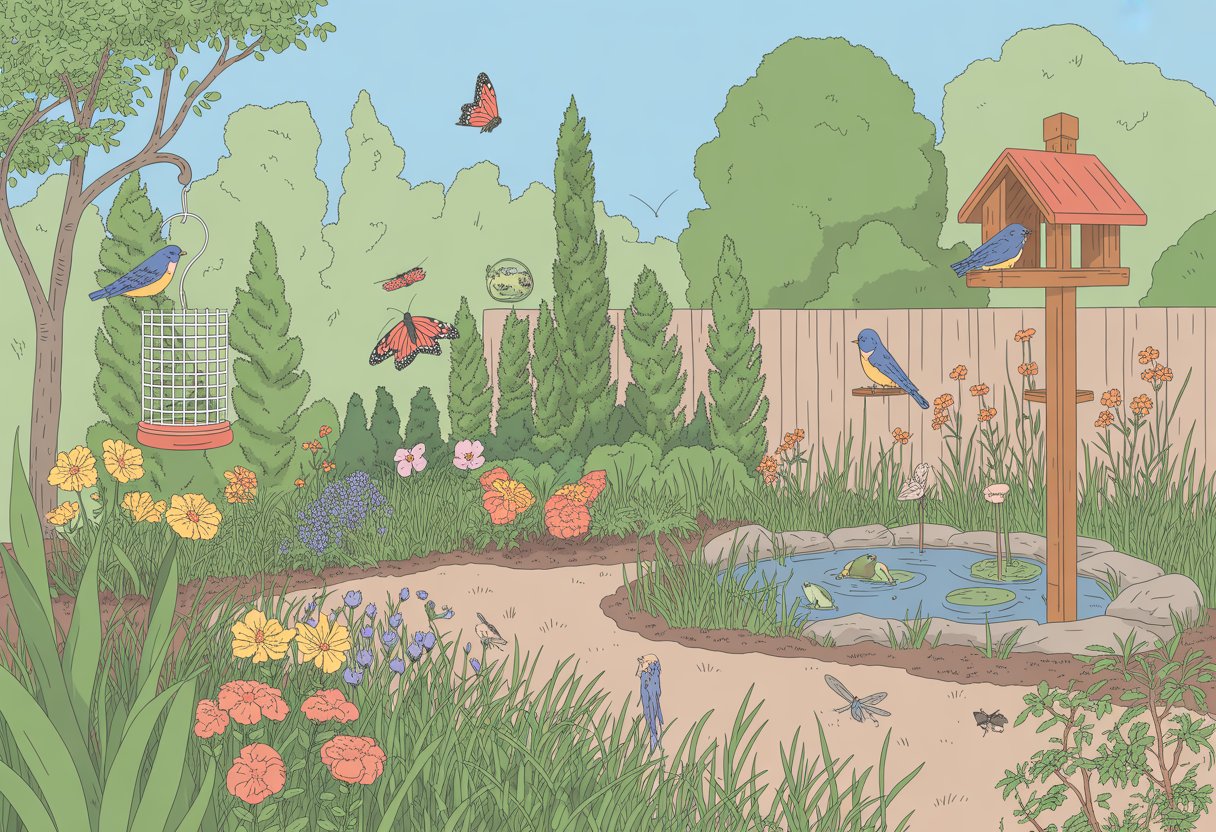
Building a backyard habitat can feel personal, but it gets even better when you connect with others. Conservation groups, citizen science, and swapping tips locally can really ramp up your impact.
Partnering with Conservation Organizations
Groups like the National Wildlife Federation and Audubon Society have a ton of resources and advice. They run habitat certification programs—like the NWF’s Certified Wildlife Habitat—that recognize wildlife-friendly yards.
You’ll find workshops and community events, too. Volunteer for restoration projects or bird counts with your local Audubon chapter. It’s a great way to link your backyard effort to bigger conservation goals.
Many organizations share native plant lists and tips tailored to your region. That way you’re supporting local wildlife in the best way possible.
Participating in Citizen Science and Monitoring
Apps like iNaturalist let you record wildlife sightings and share data that actually matters. Tracking what shows up in your yard helps scientists keep tabs on biodiversity.
Citizen science programs often team up with universities or agencies. Your notes can influence research and shape how habitats get managed elsewhere.
Checking in regularly on your yard keeps you engaged and sharpens your sense of the natural cycles. It’s a small thing, but it really deepens your connection with the wild life around you.
Sharing Your Habitat with Neighbors
Promoting backyard habitats in your neighborhood can really spark some collective wildlife-friendly action. When you share info in local groups or on social media, you might just inspire a neighbor to plant something native or swap out pesticides for something gentler.
Neighborhood workshops or even casual garden tours let people show off what’s working. Honestly, seeing someone else’s bird feeder setup or pollinator patch can be way more convincing than reading a pamphlet.
If folks collaborate, they can piece together habitat corridors that stretch through the whole area. Suddenly, local wildlife has more space and resources, and the whole ecosystem gets a bit stronger.

